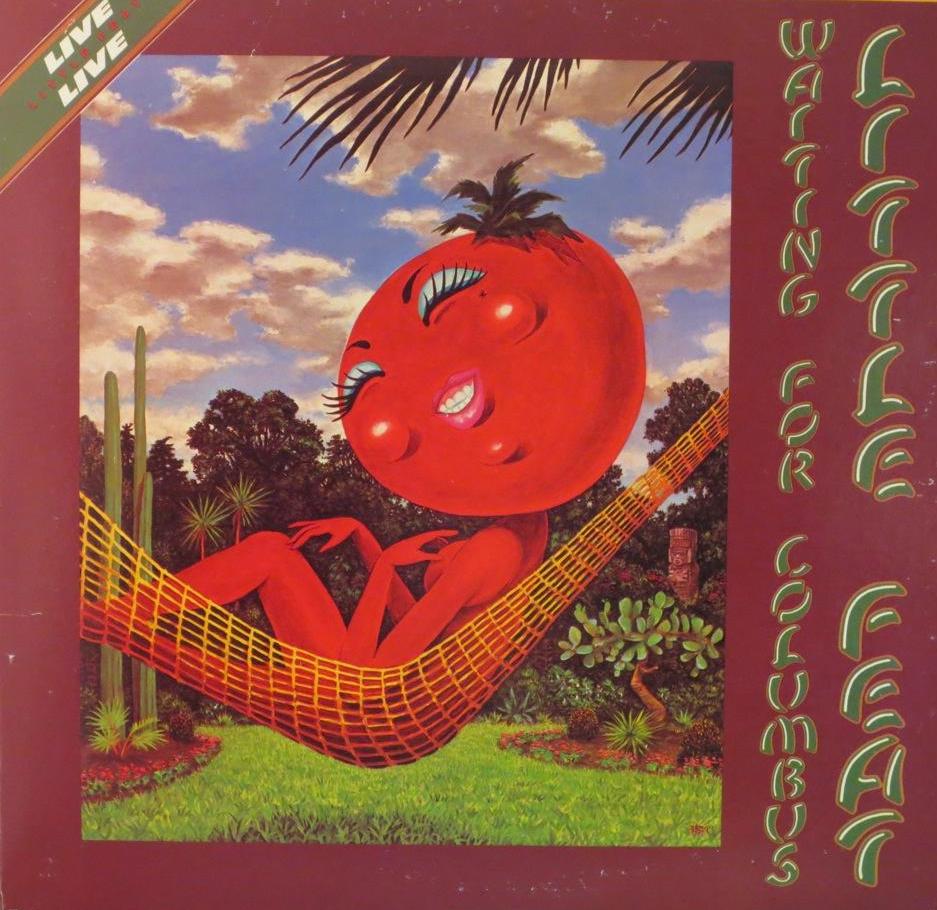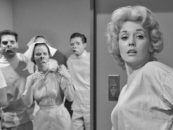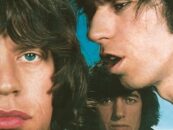 As the six-piece American band Little Feat settled into London’s Rainbow Theatre on August 1, 1977, for the first of four shows, the band had split into factions and the musicians were barely speaking to each other. The extraordinary slide guitarist Lowell George, who’d co-founded the band in 1970 after a stint with the Mothers of Invention, had backed away from any leadership position during the sessions for their most recent studio releases The Last Record Album and Time Loves a Hero. There was plenty of talent in the band to fill the gap, but there was a price to pay.
As the six-piece American band Little Feat settled into London’s Rainbow Theatre on August 1, 1977, for the first of four shows, the band had split into factions and the musicians were barely speaking to each other. The extraordinary slide guitarist Lowell George, who’d co-founded the band in 1970 after a stint with the Mothers of Invention, had backed away from any leadership position during the sessions for their most recent studio releases The Last Record Album and Time Loves a Hero. There was plenty of talent in the band to fill the gap, but there was a price to pay.
Little Feat members had always enjoyed recreational drugs and heavy partying, but George was now fully in the grip of a destructive cocaine habit. He often refused to rehearse or jam, disappeared for days at a time and virtually stopped writing songs, leaving production decisions and music construction to keyboardist Bill Payne and guitarist Paul Barrere. In an interview with journalist Bud Scoppa, Barrere described ’77 Little Feat as “without focus or direction, no real managerial control over the business aspect, and because our personal habits were so askew, clear thinking was not a part of the ball game.”
How the group pulled off one of the best live albums of all time, the double-LP Waiting for Columbus, is both a heartening story of persistence and a sad, cautionary tale about how band politics can become toxic, and destroy a beautiful thing in the process.
When Lowell George proposed doing a live album in early 1977, the group approved the idea at least partly, because they considered it a good sign that George was involving himself in any decision-making.
They were also anxious to capture their onstage power in the way the Allman Brothers Band, the Rolling Stones, Neil Young and the Band had before them. Little Feat made plans to include the five-piece Tower of Power horn section (Mic Gillette and Greg Adams on trumpets, with Lenny Pickett, Emilio Castillo and Stephen “Doc” Kupka playing saxophones), incorporating new super-funky arrangements inspired by Allen Toussaint’s work with the Band on Rock of Ages.
Four concerts in London were recorded, along with a warm-up show in Manchester, with engineers George Massenburg and Andy Bloch running the 24-track Manor Mobile Unit, supplemented with three shows at George Washington University’s Lisner Auditorium in Washington, D.C., a week later, with engineering by Warren Dewey, assisted by Bloch. Extensive overdubbing sessions at Westlake Audio and Sunset Sound in Los Angeles were later arranged to repair some guitar tuning problems and vocal flubs.
According to Dewey, no keyboard or drum parts were re-recorded, but George re-did practically every vocal and guitar part.
On the original two-LP set the concerts’ song order was reconfigured for more dramatic effect, with nine performances from D.C. and eight from London. The Rolling Stones’ Mick Taylor guests on “A Apolitical Blues” from the August 3 gig, which was otherwise excluded from consideration; it was subsequently known as the “Black Wednesday” show by the band. Barrere and George were seriously hungover after staying up all night with some of the Tower of Power members after the second show. Castillo told writer Ben Fong-Torres for his Willin’ band biography that Hayward and George got into a screaming match just before going on stage, with punches thrown. Road manager Doug Zahn prevented Hayward from physically attacking George, who started the fisticuffs. Other band members reportedly fought in the dressing room after the show as well. Massenburg called the evening “f**king tragic.”
When in professional mode on stage, Barrere and George occupied the center, flanked by bassist Kenny Gradney on one side and Payne on the other, with drummer Richie Hayward in the back and conga player/percussionist Sam Clayton stage left with the Tower of Power Horns behind him. Following the lead of his favorite blues masters, George used a Sears & Roebuck 11/16-inch socket as his slide, favoring Fender guitars, and Barrere (no slouch as a slide player even if overshadowed by George) also went with Telecasters and Stratocasters. Payne played an Oberheim four-voice synthesizer, stacked on a Wurlitzer electric piano and his trusty B-3 Hammond organ. A baby grand piano was also within reach. The Little Feat sound was rich, the rhythms tight, the lyrics wryly humorous, and the whole band exuded an infectious New Orleans-Meets-Los Angeles vibe.
The opening track “Join the Band” was recorded in a stairwell at the Rainbow Theatre to capture the group’s pre-show a cappella bonding ritual, and then “Fat Man In the Bathtub” blasts in, cowbell up front in a funky, loping New Orleans-inspired pattern immediately recognizable as one of Little Feat’s go-to rhythms. Payne assays a subtle synth solo, and George inserts keening slide guitar lines. The great Barrere and Payne contributions “All That You Dream” and “Oh Atlanta” follow. With its opening lyric “I’ve been down/but not like this before” and swampy cross-rhythms, “All That You Dream” was one of the songs on The Last Record Album that proved Lowell George didn’t have a lock on brilliant songwriting, and in fact Barrere and Payne could extend the group’s sound into areas (like jazz and prog-rock) that George disdained and fans grew to love.
Related: A previously unpublished interview with Paul Barrere
Payne sings “Oh Atlanta,” and his honky-tonk acoustic piano is every bit as exciting as the totally cooking, Hayward/Clayton/Gradney rhythm section that runs alongside. From then on the set is like a “greatest hits” album on steroids: “Dixie Chicken,” “Rocket In My Pocket,” a “Time Loves a Hero>Day or Night” medley with Barrere on fire, and “Spanish Moon.” All rock harder than the studio versions (“Dixie Chicken” is especially transformed), and reveal more colors. Barrere and George achieve a kind of Garcia/Weir synthesis in their interactions and solo duels, and Payne moves from keyboard to keyboard always searching for something surprising. The horn section (with an incendiary Pickett tenor sax solo) shines on “Mercenary Territory,” which George sings the hell out of (probably as an overdub/live hybrid).
Clayton and Hayward start off “Spanish Moon” with an authority they maintain for the whole performance, and there are highlights galore, from George’s growling vocal to the driving horn arrangement, terrific background vocals, and pithy solos from Payne, Gradney and Hayward, before it ends rather abruptly, the crowd clapping for an encore. “You folks are crazy,” says George as Little Feat returns to the stage for an acoustic-based version of George’s classic “Willin’,” with yet another gorgeous acoustic piano solo from Payne.
A humorous, truncated version of “Don’t Bogart That Joint,” a tune done originally by Hayward’s previous band the Fraternity of Man, yields to “A Apolitical Blues,” with the Mick Taylor/Lowell George duo in high gear.
The album ends with fully electric versions of “Sailin’ Shoes” and “Feats Don’t Fail Me Now” from the last two Lisner Auditorium shows. “Sailin’ Shoes” is done more slowly than usual, and everyone contributes stellar work in the new format (this version is about three times longer than the original studio take). “Feats Don’t Fail Me Now” clearly has the crowd dancing in the aisles (you can hear them shouting encouragement to the band), and is another opportunity to stretch out the soloing, and in this case actually speed up the tempo, giving it a more Latin feel. Then it becomes a gospel tune, with tambourine, bass and drums leading, George exhorting the crowd into a call-and-response as he roams the stage.
Released February 10, 1978, Waiting for Columbus made it to #18 on the Billboard 200 album chart, but the group was already splitting. Payne told Scoppa, “What broke up the band was the fact that we were getting less and less of that excitement that comes from playing great as a unit. We blew past it somehow on that tour.”

This ad for the album appeared in the Feb. 25, 1978 issue of Record World.
Lowell George became a producer-for-hire, and began work on a solo album that was eventually issued as Thanks, I’ll Eat it Here. He died at the age of 34 while on tour promoting it, ironically playing the Lisner Auditorium a final time on June 28, 1979, succumbing after a heart attack the next day, most likely brought about by a cocaine overdose. Little Feat eventually regrouped, and with many different lineups they made fantastic music for decades. Hayward was killed by cancer in August 2010, as was Barrere in October 2019. Of the survivors, Payne has been the most active, working most recently with Leftover Salmon and the Doobie Brothers.
Waiting For Columbus’ cover art by Neon Park (Martin Muller) still confounds easy interpretation, and forms part of the mystique of the album. Is the anthropomorphic tomato-woman a symbol of idyllic America, before Columbus “discovered” her? Three additional outtakes were included on the 1981 Little Feat compilation Hoy-Hoy! and seven more emerged on the Rhino reissue in 2002. The album received a significantly expanded edition in 2022. It, along with their other recordings, is available in the U.S./worldwide here, in Canada here and in the U.K. here.
Waiting for Columbus continues to exert a big influence, especially on country, bluegrass, blues and jam bands. On October 31, 2010, Phish performed the whole album in Atlantic City as part of their annual “Halloween disguise” shows, and on July 21, 2018, the Peach Festival in Scranton, Pa., saw the remaining members of Little Feat join with moe., Turkuaz and the Midnight Ramble Horns to recreate Waiting For Columbus one more time.
Related: Our Album Rewind of Dixie Chicken
Bonus Video: Watch Little Feat perform “Dixie Chicken” (with Emmylou Harris and Bonnie Raitt) on The Midnight Special in 1977
- Smokey Robinson & the Miracles’ ‘Going to a Go-Go’: Life of the Party - 11/11/2025
- Patti Smith’s ‘Horses’: Poetry In Motion - 11/10/2025
- Rockpile’s ‘Seconds of Pleasure’: One And Done - 11/08/2025






17 Comments so far
Jump into a conversationI can attest that I was there for two of the Lisner Auditorium shows, working as an ‘usher’ since I knew someone that knew someone. It was an incredible experience.
This is a terrific article. I’m grateful for richness of detail, especially the stuff about the band’s equipment.
On a bulletin board, there was an exercise to name our top 100 albums. Beatles records dominated my list, but #1 was WAITING FOR COLUMBUS. Yeah, I know, it’s been sweetened in the studio to the point it can’t quite be called “live,” but it serves as a great de facto Greatest Hits collection of Little Feat. I’m convinced they were the greatest American band to strap on the instruments and let the music fly.
One of the best live albums ever. My second favorite to only Allman Brothers Band at the Fillmore
“Waiting for Columbus” has been my favorite live album by far for over 40 years now. Damn I’m old! I have it in both vinyl and CD and prefer the order of the songs on the LP
I’m old too. By far my favorite live album with the cd and vinyl. So good it never lacks style. I wish I’d been there in the crowd drinking jack.
Sometime around the 25th anniversary of WFC, there was a full band recreation (minus Lowell, of course) recorded live in DC. A who’s who of guest artists were involved but, for some reason, it was never released. Any info on this?
That show was October 14, 2002. It was a stellar performance, with a ton of special guests, but the recording of the night was useless — in fact, the guys will tell you they heard audience tapes that far surpassed anything that was professionally recorded that night.
Outstanding article, Mr. Leviton. Much appreciated. I was unaware of the “touching up” of the recording. I saw them live in Chicago after the release of The Last Record Album, and that performance needed NO adjusting. Greatest live performance I’ve ever seen.
A real gem of a performance captured indeed. Little Feat studio recordings are in and still listened to in the collections of many, many musicians in that rock and roll hall of fame. Timeless, Greasy, Tight, Too Funky!!!!
I’ve been listening to this album in part or in full at least once a month since its release in 1978. From cassette, MFSL and finally CD.
Here we are in 2021 and this band and this album is STILL being discussed. It is clearly time to be inducted into the RRHOF!!
Would like to know more about why Lowell thought he needed to make so many overdubs. My college fortuitously booked the Feat for a show in ’78 before Columbus was released. The show in my mind was in every way as good as the record, and the setlist was probably influenced by it. I believe the opening act was Fuller & Kaz. Fuller of course became the post-Lowell singer. Memories are made of this.
The details given here sadly explain a lot about what happened to Little Feat. While I’ve been ga-ga for them since close to their beginnings, I always felt that Waiting For Columbus, as rightfully successful as it was, didn’t actually capture their incredible musical dynamics, as I had witnessed in a previous show in 1973 at the Beacon Theater In NYC. I read here that Roy Mercer saw a similar superior show just after “The Last Record Album.” The show I saw was not long after “Feats Don’t Fail Me Now,” and all I can say is it was magical. Even before the existence of so much of their yet-to-come material, I’d never seen a band that was so intricately entwined with each other in a musical labyrinth that knew right where it was every moment, even if the audience was in the throes of a hypnotic daze that Feat effortlessly weaved throughout the night. Easily one of the best shows I’ve ever seen, out of hundreds. But I guess this was an era when the members were all more simpatico than they were by the time of “Columbus.” And as good as it may be, the fractures showed in their performance by comparisons. Now I have a better understanding of why.
With regard to some of Mr. Leviton’s assertions, which were by and large very informative. But, despite Mark’s claim, Lowell was obviously still in control in the creation of “The Last Record Album,” and was obviously quite absent in the making of “Time Loves A Hero,” where the dominating keyboards, and lack of dual-minded guitar parts almost makes the record sound like another band.
His absence may well have been drug-related, I don’t know. But, amazingly, I happened to run into Lowell, backstage at a Charlie Danials show at the Armadillo World Headquarters, In Austin, shortly have “Hero” came out, and I asked him about his obvious lack of presence on the record (among other things). He said that he had been recovering from a case of hepatitis during that period and wasn’t really able to participate much. But whatever the case, you’d have to say that that record did indeed mark the end of Lowell’s influence on the band before his death, and that the name of “The Last Record Album” was more prophetic than they knew.
One of the great opening songs of a live album fat man in the bathtub always sounds great cranked up to 10
Thanks to Mark and Best Classic Bands for continuing to celebrate and promote Little Feat, one of the greatest bands of all time. I saw them at Newcastle City Hall in NE of England on 27th July 1977 which must have been a pre-Rainbow warm-up gig. Was already fan then and familiar with their music and show didnt disappoint. Bought a Feat t-shirt which I wore till it disintegrated and have acquired all the post-Lowell Feat albums, which are good, but he’s irreplaceable. His death was announced on our BBC national radio when it happened. Their influence is impossible to underestimate, as I’m sure Robert Palmer must have felt when he secured their backing on his early albums. Still listen to all their stuff on a regular basis. There’ll never be another Feat and they certainly never failed us! Cheers Barry
Never gave Little Feat much thought until a couple of years after this album came out. A college roommate of mine had it, and slowly but surely, as the ’80s progressed, it became one of my top 10 favorite live albums. Then top 5 favorite live albums. Then top 3 favorite live albums. And I wouldn’t swear to it, but it MIGHT be in my top 1 favorite albums for the last 20-ish years, though The Guess Who’s “Live at the Paramount” and Deep Purple’s “Made in Japan” probably occupy that top 3 with WFC, and any given one of them could be #1 on my list depending on what I’m listening to on any given day.
Glad I got to see them with ZZ Top and 2 other bands – outdoors in California. They were smokin’ hot.